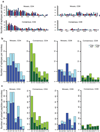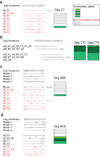Mosaic vaccines elicit CD8+ T lymphocyte responses that confer enhanced immune coverage of diverse HIV strains in monkeys
- PMID: 20173754
- PMCID: PMC2834806
- DOI: 10.1038/nm.2108
Mosaic vaccines elicit CD8+ T lymphocyte responses that confer enhanced immune coverage of diverse HIV strains in monkeys
Abstract
An effective HIV vaccine must elicit immune responses that recognize genetically diverse viruses. It must generate CD8+ T lymphocytes that control HIV replication and CD4+ T lymphocytes that provide help for the generation and maintenance of both cellular and humoral immune responses against the virus. Creating immunogens that can elicit cellular immune responses against the genetically varied circulating isolates of HIV presents a key challenge for creating an HIV vaccine. Polyvalent mosaic immunogens derived by in silico recombination of natural strains of HIV are designed to induce cellular immune responses that recognize genetically diverse circulating virus isolates. Here we immunized rhesus monkeys by plasmid DNA prime and recombinant vaccinia virus boost with vaccine constructs expressing either consensus or polyvalent mosaic proteins. As compared to consensus immunogens, the mosaic immunogens elicited CD8+ T lymphocyte responses to more epitopes of each viral protein than did the consensus immunogens and to more variant sequences of CD8+ T lymphocyte epitopes. This increased breadth and depth of epitope recognition may contribute both to protection against infection by genetically diverse viruses and to the control of variant viruses that emerge as they mutate away from recognition by cytotoxic T lymphocytes.
Figures




Comment in
-
HIV vaccines: mosaic approach to virus diversity.Nat Med. 2010 Mar;16(3):268-70. doi: 10.1038/nm0310-268. Nat Med. 2010. PMID: 20208511 No abstract available.
Similar articles
-
Mosaic HIV-1 vaccines expand the breadth and depth of cellular immune responses in rhesus monkeys.Nat Med. 2010 Mar;16(3):319-23. doi: 10.1038/nm.2089. Epub 2010 Feb 21. Nat Med. 2010. PMID: 20173752 Free PMC article.
-
Breadth of cellular and humoral immune responses elicited in rhesus monkeys by multi-valent mosaic and consensus immunogens.Virology. 2012 Jul 5;428(2):121-7. doi: 10.1016/j.virol.2012.03.012. Epub 2012 Apr 21. Virology. 2012. PMID: 22521913 Free PMC article.
-
A Novel Immunogen Selectively Eliciting CD8+ T Cells but Not CD4+ T Cells Targeting Immunodeficiency Virus Antigens.J Virol. 2020 Mar 31;94(8):e01876-19. doi: 10.1128/JVI.01876-19. Print 2020 Mar 31. J Virol. 2020. PMID: 32024773 Free PMC article.
-
Multiple Approaches for Increasing the Immunogenicity of an Epitope-Based Anti-HIV Vaccine.AIDS Res Hum Retroviruses. 2015 Nov;31(11):1077-88. doi: 10.1089/AID.2015.0101. Epub 2015 Aug 13. AIDS Res Hum Retroviruses. 2015. PMID: 26149745 Review.
-
Development of a DNA-MVA/HIVA vaccine for Kenya.Vaccine. 2002 May 6;20(15):1995-8. doi: 10.1016/s0264-410x(02)00085-3. Vaccine. 2002. PMID: 11983261 Review.
Cited by
-
Full-length HIV-1 immunogens induce greater magnitude and comparable breadth of T lymphocyte responses to conserved HIV-1 regions compared with conserved-region-only HIV-1 immunogens in rhesus monkeys.J Virol. 2012 Nov;86(21):11434-40. doi: 10.1128/JVI.01779-12. Epub 2012 Aug 15. J Virol. 2012. PMID: 22896617 Free PMC article.
-
Comparison of intradermal and intramuscular delivery followed by in vivo electroporation of SIV Env DNA in macaques.Hum Vaccin Immunother. 2013 Oct;9(10):2081-94. doi: 10.4161/hv.25473. Epub 2013 Jun 28. Hum Vaccin Immunother. 2013. PMID: 23811579 Free PMC article.
-
Cohort-Specific Peptide Reagents Broaden Depth and Breadth Estimates of the CD8 T Cell Response to HIV-1 Gag Potential T Cell Epitopes.Vaccines (Basel). 2023 Feb 17;11(2):472. doi: 10.3390/vaccines11020472. Vaccines (Basel). 2023. PMID: 36851349 Free PMC article.
-
T cell-based strategies for HIV-1 vaccines.Hum Vaccin Immunother. 2020 Mar 3;16(3):713-722. doi: 10.1080/21645515.2019.1666957. Epub 2019 Oct 25. Hum Vaccin Immunother. 2020. PMID: 31584318 Free PMC article.
-
Mechanisms and factors that influence high frequency retroviral recombination.Viruses. 2011 Sep;3(9):1650-1680. doi: 10.3390/v3091650. Epub 2011 Sep 9. Viruses. 2011. PMID: 21994801 Free PMC article. Review.
References
-
- Letvin NL. Progress and obstacles in the development of an AIDS vaccine. Nat Rev Immunol. 2006;6:930–939. - PubMed
-
- Heeney JL. Requirement of diverse T-helper responses elicited by HIV vaccines: induction of highly targeted humoral and CTL responses. Expert Rev Vaccines. 2004;3:S53–S64. - PubMed
-
- McMichael AJ. HIV vaccines. Annu Rev Immunol. 2006;24:227–255. - PubMed
Publication types
MeSH terms
Substances
Grants and funding
LinkOut - more resources
Full Text Sources
Other Literature Sources
Medical
Research Materials

